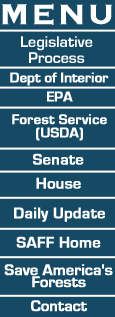

Environment and Public Works
Subcommittee for clean air, wetlands, and climate change
Hearings
Schedule
Legislation
Offiicial
Senate webpage
Contact
Information
The committee's
oversight extends to programs in five cabinet level departments and seven
independent agencies, including the Department of the Interior's Fish and
Wildlife Service, the Department of Transportation's Federal Highway Administration
and the Coast Guard, the Department of Commerce's Economic Development Administration
and National Oceanic and Atmospheric Administration, the Department of Agriculture's
Natural Resources Conservation Service, the Environmental Protection Agency,
the GSA's Public Buildings Service, the Council on Environmental Quality,
the civil works program of the U.S. Army Corps of Engineers, the Tennessee
Valley Authority, the Appalachian Regional Commission, the Nuclear Regulatory
Commission, the Federal Emergency Management Agency, the Mississippi River
Commission, and the nonperforming functions of the John F. Kennedy Center
for the Performing Arts.
Links that deal with this committee
| Majority Joseph I. Lieberman, Connecticut Harry Reid, Nevada Thomas R. Carper, Delaware Hillary Rodham Clinton, New York Jon S. Corzine, New Jersey |
Minority |
A note on the history of the Environment and public works committee
In 1837, the Senate created the Committee on Public Buildings and Grounds to oversee the development of the Federal buildings in the young, but growing Federal City of Washington, DC. In 1947, during a reorganization of Senate committees, the panel was renamed the Committee on Public Works. Following another major organizational revision in 1977, its name was changed to the Committee on Environment and Public Works.
Over the years the committee's public works jurisdiction has grown from oversight of new Federal building construction, additions to the U.S. Capitol building and grounds, and the White House and its grounds, to legislative responsibility for the development of the Nation's interstate highway system, flood control and navigation projects.
In 1963, the responsibility for creating new laws to achieve air and water pollution control, rural and community economic development, and relief from natural disasters was given to the committee. The passage of the Clean Air Act in 1970, and the Federal Water Pollution Control Act of 1972, brought the committee recognition as the Senate's forum for protection of the environment. In 1977, the committee was assigned the jurisdiction over endangered species, fish and wildlife refuges and programs, and the regulation of nonmilitary nuclear power.
More recent committee activities include the passage of landmark Everglades restoration legislation, the protection of barrier islands and ground water resources, investigation of the environmental effects of bioengineering, review of new technologies and scientific standards in achieving infrastructural growth and natural habitat renewal, and oversight of the Superfund program, solid waste and recycled materials, stratospheric ozone depletion, global climate change, private property rights, and Federal regulatory reform.
Majority
410 Dirksen Senate Office Bldg.
Washington, DC 20510-6175
202-224-8832
Minority
456 Dirksen Senate Office Bldg.
Washington, DC 20510-6175
202-224-6176
Top
